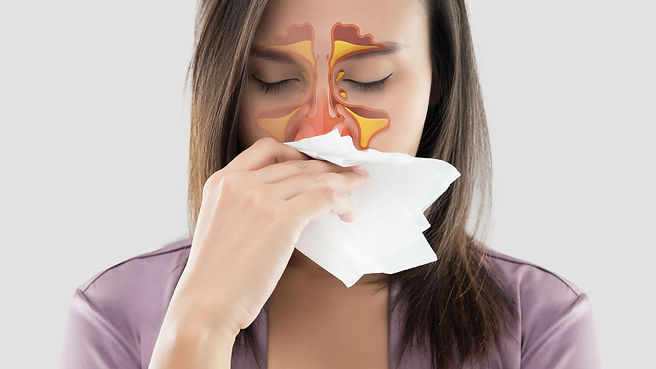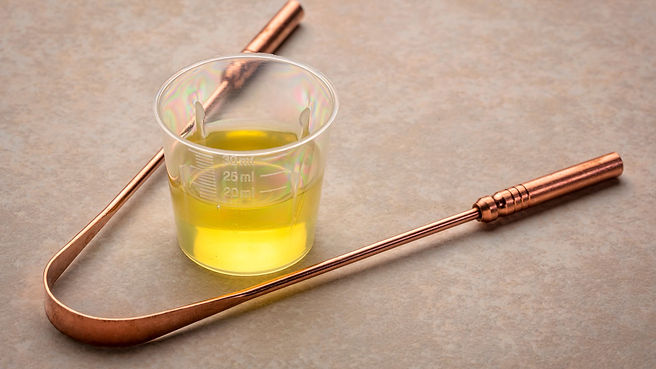Posted by Veena Haasl-Blilie
SAUMYA AYURVEDA
What is Oil Pulling? Here’s everything you need to know about Ayurvedic oil pulling treatment and its benefits. 👄 Clean our mouth, freshen your sinuses, clear your head, and improve digestion. Oral hygiene is a important part of your overall health. Ayurvedic oil pulling–it’s prevention for chronic conditions.

“Oil pulling is a powerful detoxifying Ayurvedic technique that has recently become very popular. Using this method, surgery or medication could be prevented for a number of chronic illnesses. The oil therapy is preventative as well as curative.” (National Institute of Health)
How To Do Ayurvedic Oil Pulling and Its Many Health Benefits
According to a New York Times article, “Gum disease has been associated with a range of health conditions, including diabetes, heart disease, dementia and more…If large amounts of bacteria from the mouth are inhaled and settle in the lungs, that can result in bacterial aspiration pneumonia, said Dr. Frank Scannapieco, a professor of oral biology at the University at Buffalo School of Dental Medicine.”
Did you know that “About 47 percent of people aged 30 years and older in the United States have some form of periodontal disease, according to the Centers for Disease Control and Prevention.” That’s an alarming number.
Here are two easy Ayurveda lifestyle tool you can use to begin to reduce oral bacteria, moisten the gum tissue, and freshen the breath all supporting overall health.
Enjoy our video, A Beginner’s Guide to Ayurvedic Morning Routine.
Ayurvedic Oil Pulling: So Much More Than an Oral Treatment
Oil pulling is a traditional Ayurvedic treatment which has existed for more than 5,000 years. According to the National Institute of Health, oil pulling “…is believed to cure more than thirty systemic diseases when practiced regularly and as directed. Due to occurrence of side effects to modern medicines and oral hygiene products, people are increasingly attracted towards complementary and traditional practices. Oil pulling in addition to offering several oral health benefits has also beneficial effects on overall health.”
In the Charaka Samhita and Sushruta Samhita, two ancient traditional sacred texts of Ayurveda, two oil pulling treatments are discussed.
-
Kavala Graha: A comfortable amount of oil is placed in the mouth and the oil is swished and pulled briskly moving it throughout the oral cavity and between the teeth and spitting it out fairly quickly.
-
Kavala Gandoosha: In this treatment, the mouth cavity is completely filled with oil, no gargling is possible because there is no room. Hold the oil or medicated water in the mouth. It is to be held in the mouth until there is salivation, tears from the eyes or discharge from the nostrils.
Today, when people think about oil pulling, it is usually Kavala Graha.
Related Resources: Ayurveda Tongue Diagnosis: What Your Tongue Is Saying About Your Health Ayurvedic Tongue Scraping | Why and How? Ayurveda Organ Locations on the Tongue

Benefits of Ayurvedic Oil Pulling
1. Reduces bacteria in the oral cavity.
According the National Institute of Health, “The oral cavity has the second largest and diverse microbiota after the gut harboring over 700 species of bacteria.”
-
“…study observed 20% reduction in bacterial count upon 40 days of oil pulling using sesame oil. Also, they observed reductions in the severity of dental caries. Sesame oil was observed to possess moderate antimicrobial activity against S. mutans and L. acidophilus. They mentioned that toxins and bacteria from the body may be removed through the tongue and get trapped in oil and thrown out from the body.” (NIH.)
-
This is the reason, in Ayurveda, tongue scraping is also part of the morning routine. To learn about how Each Dosha Benefits from Using an Ayurvedic Tongue Scraper, click here.
2. Freshens breath.
No one likes morning breath to taste it or to smell it. Oil pulling freshens the mouth. Halitosis is a by-product of bacteria so addressing the bacterial load at the root, leads to fresher breath.
3. Supports healthy teeth and gums.
A happy oral microbiome supports healthy teeth and gums. Oil pulling reduces the number of bacteria in the mouth. Also, in part, come recession is due to drying of the tissues, so giving gum tissue a daily oil massage serves to moisten the tissue.
4. Supports healthy sinuses.
The mouth and sinus tissues are neighbors. Every wake up clearing your throat in the morning? The sinuses produce more than a liter of mucus per day and we’re swallowing it day and night. Excess dosha can take up residence in the sinuses (think stuffed, inflamed, or dry sinuses) and the mind. From an Ayurvedic perspective, oil pulling reduces excess Vata, Pitta, and Kapha dosha.
Related Readings:
Ayurvedic Sinus Treatments | How to Prevent Sinusitis & Respiratory Infections with Ayurveda 9 Ayurvedic Sinus Treatments | Nose Oil and More! Nasya Oil – Benefits and Guide to Nasya Treatment
5. Daily Detoxification of the Inner Organs and the Tongue.
According to Ayurveda, the tongue is a powerful and primary diagnostic tool in determining one’s state of health. The tongue is viewed as connected to the inner organs such as kidneys, hearts, lungs, intestines, etc. Looking at the corresponding organ locations on the tongue provides specific details. For example, a discoloration or change in texture on the tongue, may indicate a disorder in that corresponding organ.
Oil pulling, combined with Ayurvedic tongue scraping, gently stimulates the inner organs and is said to provide a gentle cleansing action.

Oil Pulling is More Than an Ayurvedic Oral Treatment
6. Supportive of Overall Health and Disease Prevention | Anti-Inflammatory
Oral health is connected to our overall health. According to Harvard Medical School, “The bacteria that infect the gums and cause gingivitis and periodontitis also travel to blood vessels elsewhere in the body where they cause blood vessel inflammation and damage; tiny blood clots, heart attack and stroke may follow.”
By reducing inflammation in the gums, it may reduce inflammation throughout the body. (see #7)
7. Reduces Microbial Load and Supports Healthy Sinuses
At first oil pulling seems to be all about oral health, it’s that and so much more. While oil pulling removes ama (toxins) helping to keep ama from entering the body’s inner ocean (rasa and rakta, think circulation), and spreading throughout the body.
Sinus infections, for example, are the result of microorganisms building up in the sinuses. According to Ayurveda, oil puling helps reduce the microbial load and is a remedy for sinus problems.
Oil pulling may also help alleviate allergy symptoms.
8. Alleviates excess doshas in the head, neck, and mind
According to Ayurveda, oil pulling reduces excess doshas in the head, neck and mind. If Vata is high in the mind (anxiety, excess thinking for example), it may soothe and promote calmness.
If Pitta is high (overly intense, irritable…), oil pulling may cool off a hot head. Tight shoulders, headaches, stress, and muscle tension-oil pulling may put you at ease.
Most of us experience shoulder and neck tension from time spent on computers. Try oil pulling and nasya and see if tension begins to melt away.
Gum Disease and Heart Disease
I learned from my dog’s veterinarian decades ago, that the mouth and heart are directly connected. The vet explained that my dog’s teeth needed to be cleaned annually to prevent gum inflammation and disease. The microbes that can travel through the bloodstream and into the heart. Now, there is research about the connection of gum and heart disease as it pertains to humans.
“Researchers suspect that bacteria present in gum disease can travel throughout the body, triggering inflammation in the heart’s vessels and infection in heart valves.” according to Penn Medicine.

Which Ayurveda Oil to Use for Oil Pulling?
1. Sesame oil: Known as the “King of Oil” because it is nutrient rich. Traditionally sesame oil is used for oil pulling. Sesame oil is considered the oil for pulling and is the best oil for everyone.
2. Our Swishing Oil: Supportive of dental health. It’s refreshing and pleasing. Our Swooshing Oil is made with *Sesame Oil, Olive Oil, *Peppermint, Frankincense, *Myrrh. Ahhh….
How To Do Ayurvedic Oil Pulling
Oil pulling is an Ayurvedic treatment that alleviates excess doshas in the head and mind. It helps cleanse oral ama – or toxins – to ease congestion and support healthy sinuses.
An experienced Certified Ayurvedic Practitioner can assess your prakruti (constitution) and vikruti (current state) to determine which type of oil is optimal for your doshic balance. After this, the process is simple:
-
Perform oil pulling in the morning as part of your Ayurvedic morning routine (dinacharya).
-
Place one tablespoon of oil in your mouth (sesame oil).
-
Swish the oil through your teeth and gums for 10-20 minutes.
-
Spit the oil in the trash or toilet when you’re finished. Don’t swallow it or spit it in the sink.
When To Do Oil Pulling
You want to do oil pulling with a clean mouth. Oil pulling is done in the morning on an empty stomach. So, brush and floss and then do your Ayurvedic oil pulling.

Complete Ayurveda Oral Routine
As part of your morning routine, include Ayurveda oral care (Danta shastra).
-
Scrape your tongue. Benefits from Using an Ayurvedic Tongue Scraper.
-
Floss or use a water flosser.
-
Brush your teeth. (Look at the ingredients of the toothpaste.)
-
Perform oil pulling.
When you’re just getting started, start with five minutes and work your way up to 15 or 20. The oil may quickly change consistency and color at first, which means it’s full of oral gunk. If this happens, spit it out and continue the following day.
Oil Pulling FAQs
-
Should I spit or swallow the oil? SPIT!
-
Is it OK to do oil pulling everyday? Yes.
-
Can oil pulling reverse gum disease? It might help in conjunction with your full Ayurveda plan.
-
Do I brush my teeth after oil pulling? Yes.
-
Which oil is best for oil pulling? Sesame. The King of Oils.
-
When should I do oil pulling? Oil pulling is best done in the morning, upon rising, and on an empty stomach. Not at night, not after lunch.
